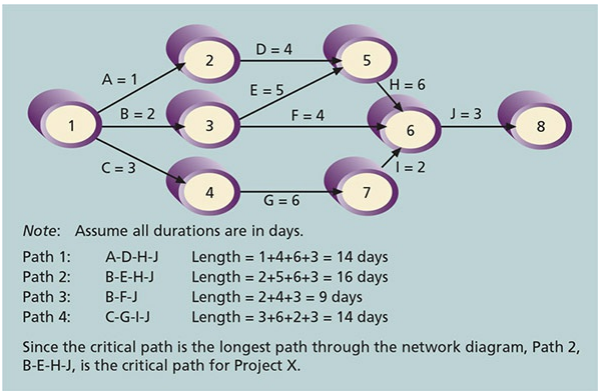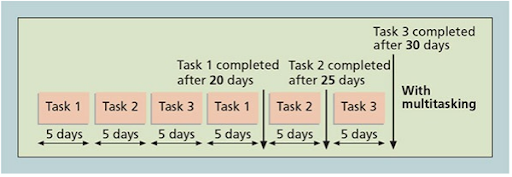Developing Project Schedule
Introduction
Developing a schedule for a project is an extremely important step in the project development process. Without a well thought out and planned schedule the project will suffer many different complications as well as a huge lack of coordination between all of the members working on the project, noone will know what they need to do, when they need to do it, and how it needs to be done. There are a few different ways that you can develop a schedule for a project, you could use Gantt charts, you could use the Critical Path Method, or you could use Critical Chain Scheduling.
Gantt Charts
Gantt Charts are simple charts that help with developing a schedule. Gantt Charts are a standard format for displaying project schedule information. They list project activities with start and finish dates. Gantt Charts can sometimes be displayed in a horizontal bar chart. If you'd like to make a Gantt Chart Microsoft provides a software that you can use to make the charts. Since the Gantt Charts display the activities it's important to make sure that all of the activities displayed are Specific to make sure there is no confusion on anyone's part, Measurable to insure that if an activity is completed you can measure its success, Assignable so that anyone can do it, Realistic in the sense that it can be done, and finally Time-framed to insure that there is enough time to complete the activity but not too much time so that the activity is completed but there is still a lot of time left. With all of the activities in the Gantt Chart it's important to keep track of how long it takes to complete each activity. Gantt Charts can also display the time it took to complete the activity. This is important because with each successful project you can learn roughly how much time you need to complete individual activities.
Critical Path Method
The Critical Path Method is a network diagram technique that is used to predict the total project duration. Using this method it helps combat project schedule overruns. In the Critical Path Method there is something called the Critical Path, the Critical Path is the series of activities that determine the earliest time by which the project can be completed. When going through the critical path method the longest path has the least amount of slack or float, slack or float is the amount of time an activity can be delayed without delaying the project's finish date.
(Determining The Critical path for a project)

Since the Critical Path Method allows you to see the amount of time it takes to complete a project and each activity you can use this information to the project team's advantage. If the stakeholders want to make a change you can use the slack or float from other activities to artificially extend the time you have to complete the project. Since you know how much slack and float you have you could also use the leftover time to shorten the project entirely and release it sooner than anticipated. It's very important to keep the Critical Path data up to date, each time an activity is completing without using the slack you can give that extra time to another section of the project, and if the slack of one activity is used its important to update that so that the project doesn't get released early if some of the people working on the project believe they can.
Critical Chain Scheduling
Critical Chain Scheduling is another scheduling technique that addresses the challenge of meeting or beating deadlines. The Critical Chain Scheduling uses the philosophy of the chain and its weakest link. It states that any project can be slowed down or even destroyed if one aspect of the project isn't very stable. Once the "weakest link" is found the entire project is managed around that "link". Another aspect of Critical Chain Scheduling is multitasking, even though a lot of the time multitasking is seen as a good idea, in the concept of Critical Chain Scheduling it is actually a negative. These two charts help better explain that concept.
(Three tasks without Multitasking)

(Three tasks with Multitasking)

With critical thinking chain scheduling there is often a buffer given to the project team just in case something goes wrong. A lot of the people in project management believe in the idea of Murphy's Law; if something could go wrong, it will go wrong.
Summary
There is a lot of thought that goes into developing a project schedule, there's the activities needed to complete the project, the time it'll take to complete each of those activities, who will be assigned what parts of the project. With all of these things that need to be kept track of there are a lot of different ways to store this information. You could use Gannt charts which are the most simple ways to store this information. The information is stored in a horizontal bar chart with each row displaying the activity and how long it will take to complete that activity from start to finish. There are also additional lines that display how much time it actually took to complete the project and those additional lines can be used in future projects to help better predict how much time will be needed. Critical Path Scheduling is a more complex way of schedule development. It uses a web of sorts that allows you to see the different paths and get an estimate of how long the project will take. Slack and float is also visualed in this chart and can be used to artificially decrease the time it will take to complete the project. Finally Critical Chain Scheduling is a way of scheduling multiple tasks on different projects to one person. Though many people might think that multitasking and working on multiple projects at once may be more efficient, it often leads to problems and can further delay the project's planned release date.